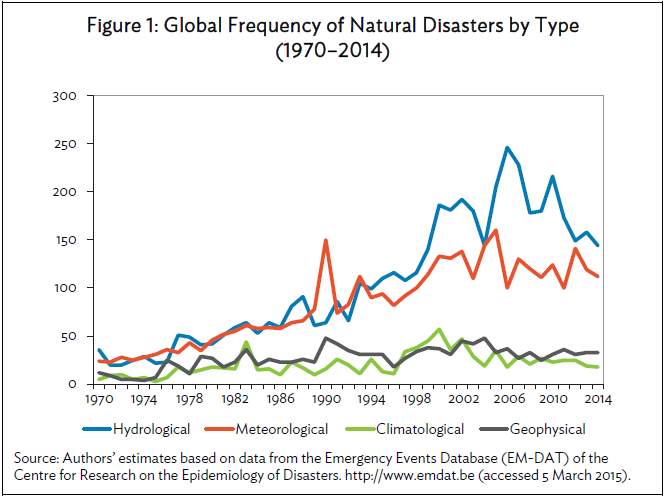Why the Paris agreement is about more than climate change

Image: Droplets of water fall from a melting ice block REUTERS/Benoit Tessier
Stay up to date:
Climate Crisis
Last December, nations represented at the Paris Climate Change Conference agreed to step up their efforts to counter the threats of climate change in the Paris agreement. But if it proves successful, it will be so because it also enables progress in two other areas: the fight to eradicate poverty and build resilience to natural disasters with economic development. Will the agreement kill three birds with one stone?
There is of course the core financial commitment. The multi-year Paris agreement will promote multistakeholder collaboration with the release by developed nations of more than $100 billion a year in funding for the adoption of the new technologies needed for global sustainable development. This represents a substantial pool of resources for developing nations that will be able to access novel financing mechanism such as the Green Climate Fund, the Global Environment Facility and the Adaptation Fund.

But building resilience and battling poverty are just as important. At Agility, as an integrated logistics company, we have seen up close how communities and business have suffered dramatically and terribly with natural disasters that are compounded by the cycle of poverty that is created by unsound economic development. Through the Logistics Emergency Team, a public-private partnership launched and facilitated by the World Economic Forum since 2005, our company has joined other global multi-nationals and humanitarian partners to respond to these sudden climate crises in more than 20 humanitarian operations.
We have seen on the ground how these events have continued to strike developing nations with greater ferocity each year. Due to the lack of sufficient resources for the building of proper emergency preparedness and response systems, these nations have been unable to break the vicious cycle of poverty that is bleeding and limiting their sustainable development.
According to a recent Asian Development Bank report, global damage from natural disasters has reached about $142 billion annually, a substantial increase from $36 billion a year between 1985 and 1994. The report also notes that the frequency and number of people impacted by natural disasters is also increasing. The same report notes that from 2000-2009, almost 80% of natural disaster-related deaths occurred in the 40 countries that received the most humanitarian aid. The Paris agreement will help to break this cycle.


How does it do this? Disaster-prone developing nations are afflicted by a host of development challenges that are compounded by humanitarian disasters and inability to adapt to environmental change. These development and adaptation gaps include insufficiency in infrastructure, roads, rails, ports, electricity, fuel, telecom, food, healthcare, institutions, technical expertise and other similar development resources. The UNFCCC projects that by 2030 adaptation costs will range from $28 billion to $67 billion a year for climate-affected developing countries. The Paris agreement provides some of the required funding to accountably and directly address development challenges and adaptation issues. The agreement’s adaptation and development funding will help us break the cycle of stifling disasters in at-risk countries.
In addition to humanitarian disasters, we have also seen a six-year period of global economic malaise. It has imperiled our communities and our businesses by stifling economic development in many places around the world. There is a lack of positive disruptive change, and limited appetite for risk-taking. Global economic growth has been stunted, and the World Bank and IMF both project global economic growth to be around 3% in 2016-2017. We need a change, and the Paris agreement delivers us an opportunity for global economic growth through sustainable disruptive change.

We all want a clean and healthy environment. We all want disaster risk reduced. We all want poverty eradicated. We all want people to have access to economic opportunity and development. We all want a rapid development of cleaner technology. And we all want our collective global economic stagnation to end. This agreement helps us achieve all of this. It transparently injects massive amounts of public and private capital into a managed programme that will form the basis of sustainable economic and social development around the world. It will accelerate the development and employment of new technologies that will benefit all of us. We welcome and embrace this agreement.
Since our business relies on vibrant communities and a sustainable global economy, this agreement is good for our communities, our environment and our business. It delivers sustainable and disruptive change that will benefit our developed and developing operations alike. We are eager to see this agreement’s impact when the committed funds are disbursed in the developing world in the next year. We are looking forward to the implementation of the various Nationally Determined Contributions that will reduce carbon dioxide emissions from 15-60% in many participating countries. These actions will help enable the development of new technologies, and they will create new business opportunities for all of us. And we are looking forward to a day when this agreement will reduce disaster risk and enable disaster resilience by helping eradicate poverty through sustainable development and positive disruptive change in our economies.
Author: Frank Clary, Senior Manager, Corporate Social Responsibility, Agility
Don't miss any update on this topic
Create a free account and access your personalized content collection with our latest publications and analyses.
License and Republishing
World Economic Forum articles may be republished in accordance with the Creative Commons Attribution-NonCommercial-NoDerivatives 4.0 International Public License, and in accordance with our Terms of Use.
The views expressed in this article are those of the author alone and not the World Economic Forum.
Forum Stories newsletter
Bringing you weekly curated insights and analysis on the global issues that matter.
More on Climate ActionSee all
Luis Antonio Ramirez Garcia
April 24, 2025
Christian O. Deseglise and Louis Downing
April 24, 2025
Sarah Franklin and Lindsey Prowse
April 22, 2025
Jeff Merritt
April 22, 2025
Elizabeth Mills
April 17, 2025






